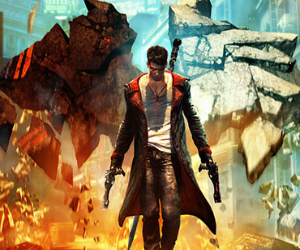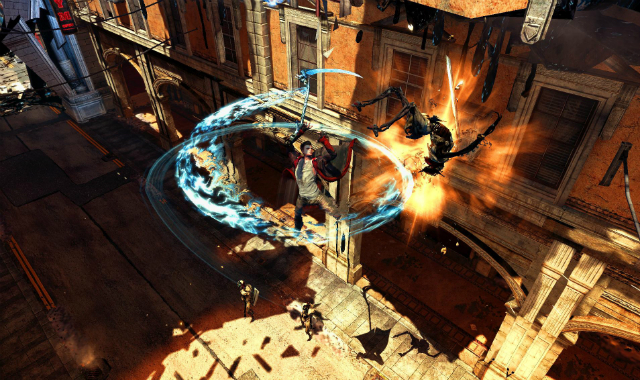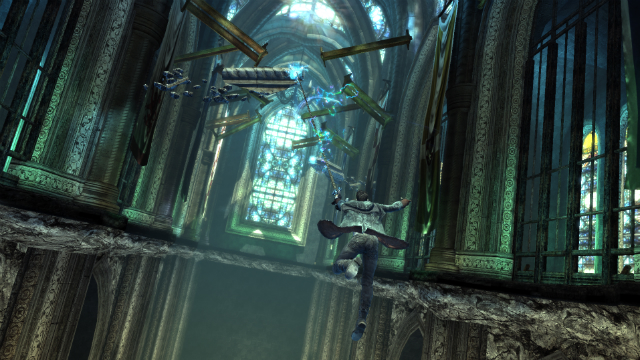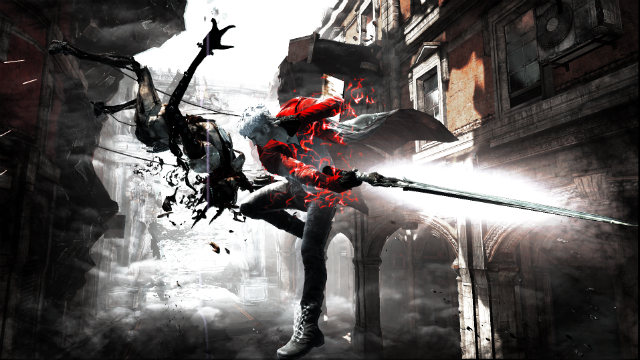DmC: Devil May Cry Review
 Game: DmC: Devil May Cry
Game: DmC: Devil May Cry
Developer: Ninja Theory
Publisher: Capcom
Available on: Xbox 360, PlayStation 3, Windows PC
Reviewed on: Xbox 360
A lot of games have been announced over the past couple of years, but nothing could compare to the outcry on the internet when Ninja Theory and Capcom revealed their new look for Dante, the main character of the Devil May Cry series. For a good couple of months it was like the Marmite of the video gaming world; some people loved it, others absolutely detested it and very few people sat comfortably on the fence. Ninja Theory had previously been known for creating games that are very story driven, so they seemed like an odd choice to develop the reboot of the popular franchise – surely someone like Platinum Games would be more suited to the role? Well, I’m here to tell you that not only were Ninja Theory absolutely the correct choice for this undertaking, but they knocked it out of the park too. No longer is Devil May Cry a frenzied brawler with very little substance other than massive combo chains and big scores – it’s an emotional rollercoaster with everything we’ve always loved and more. It’s a brand new character, it’s a deep and engaging storyline – it’s DmC.

STORY: DmC: Devil May Cry is a total reboot of the Devil May Cry franchise that we know and love, but that doesn’t mean everything has been taken out and replaced, more that it’s all just been shuffled around a little bit. The first level of the game introduces us to the brand new Dante, an emo-looking young man who prefers to dwell in the dirtier sides of life, needless to say. When we’re first introduced to our unlikely hero he’s naked, and answers the door that way when Kat calls on him to tell him that a Hunter Demon is on his way.
When it was announced that Ninja Theory would be taking the reigns of the DmC franchise, one thing we were sure of was that we would be getting a decent story, and they haven’t let us down. The entire narrative is peppered with moments of genuine humour, sections of heartfelt emotion all surrounded by a plot that’s been crafted surprisingly well for a game in the Devil May Cry series. This is a new dawn for Dante and the DmC franchise, something which was sorely needed and, at least in the story sense, Ninja Theory have most certainly delivered.
GRAPHICS: DmC: Devil May Cry is rather visually impressive too, for the most part. The game makes use of Epic’s Unreal Engine 3, and most people will know what the upsides and downsides of that are. The biggest downside is that texture popping makes an appearance throughout the game, and in some cutscenes is so bad that it’s actually rather distracting from the story. Apparently this isn’t a problem on the PlayStation 3 version of the game, but when playing on the Xbox 360 it can rear its ugly head with annoying regularity. Eventually you’ll get used to it, and although it never really takes you fully out of the game, it does break the immersion a little bit which, with a story as impressive as DmC’s, you never want to happen if you can help it.
Where the game is let down by the sheer amount of texture popping, it makes up for it with some rather impressive visuals. Dispersed throughout the game are sequences – and sometimes even entire levels – where the visuals are manipulated in such a way that players will be confused as to whether they’re even playing the same game any more. That’s not a bad thing, but rather it’s a testament to the amount of work that the new developers have put into the series. A lot of players will be genuinely shocked when they see some of the later levels of the game and, if there’s a sequel in the future, it’s the one part of the game that I definitely want to see more of.
SOUND: It would be impossible to talk about the sound design in DmC: Devil May Cry without discussing the voice acting throughout the title. All of the characters, from Dante all the way through to some of the characters that only appear in a couple of levels, are voice acted to such a high calibre that they add a sense of emotion that you wouldn’t normally associate with a game from the Devil May Cry series. Once scene about half way through even brought a tear to my manly Northern eyes.
If you’re a fan of Combichrist then you’re going to enjoy every single one of the battles in DmC. Each time the fighting starts, the music kicks off and you’ll be treated to a massive earful of Aggrotech (yeah, I had to look it up too) until all of the enemies are a shattered memory and a blood stain on the cutting edge of Dante’s trusty sword, Rebellion.

GAMEPLAY: The series’ core gameplay mechanic of slashing and shooting everything in existence is still present and correct in DmC. Dante is primarily equipped with Rebellion and his twin pistols, Ebony & Ivory, but it’s not long before players will have unlocked the first new mechanic in Dante’s arsenal. This version of Dante is not only half-demon, but half-demon and half-angel, which means that he can tap into both his demonic and angelic sides as and when he wishes simply with a pull of the left or right triggers (on the Xbox 360 version, but likely to be the L2 and R2 buttons on the PlayStation 3). Tapping into these new abilities will give Dante access to both an angelic and demonic set of weaponry, each with their own abilities and uses. There are certain aspects of the game that can only be accessed with particular weapons, and fully understanding and implementing all of these weapon types is the only way the you’re going to be able to get to the end of the game without problems, especially if you want to attain those elusive ‘SSS’ ranks.
One of the most important aspects of a Devil May Cry game is the ranking system and players will be happy to know that it’s back taking centre stage in Ninja Theory’s DmC. While you’re playing the game, cutting through the swathes of enemies that will be coming down on you, your rank will gradually increase from ‘D’ all the way through to ‘SSS’. If you get hit or stop hitting enemies for an extended period of time, that rank will drop back down significantly and you’ll have to work at getting it back up all over again. To increase the rank quickly, the player must use a combination of moves, dodges, special combos and more. Using the same move over and over again to dispatch your enemies will start to become less and less effective until it really does nothing at all. At the end of each of the levels you’ll be given an overall rank that’s based on your skill rating (how many times you got ‘SSS’ rank throughout the level, for example) as well as how quickly you finished the level, how many items you used and how many times you died. This ranking system lends itself extremely well to the replayability of DmC, as a lot of players won’t be happy looking at their list of completed levels where most are ‘S’ or above, and then seeing a solitary ‘A’ – that level is going to need completing again if you’re anything like me.
The gameplay doesn’t have to stop just because you’ve finished the game, either; there’re plenty of reasons to go back into the game and play some more, especially since once you’ve finished the game you’ll have all of the weapons available to Dante, so you can finally get into those places that you just couldn’t reach on your first playthrough. Finding all of the secret areas, playing through all of the secret missions and collecting everything in sight would be enough for most people but there’s enough content in DmC to keep you occupied for a good long while, even if the main campaign is relatively short.

LONGEVITY: Once you finish DmC: Devil May Cry for the first time, you’ll unlock the brand new ‘Son of Sparda’ mode where you can play through the entire game again but with much more difficult enemies that move through different patterns. Once you’ve completed the game on ‘Son of Sparda’ mode there are even more difficulties unlocked, all with unlockable concept art and achievements associated with them, so even though the main game is only just over six hours long, you’re going to be playing it for much longer than that. Even if you just want to play through the game again to unlock all the areas that you couldn’t get to when you first played because you didn’t have the correct equipment, you’ll still be spending a great deal of time with it.
VERDICT: All of the people that were worried that the Devil May Cry series would be damaged beyond repair needn’t worry any more. DmC: Devil May Cry is one of the best games in the series without a doubt, from the moment it starts you’ll be enjoying the frenzy, laughing at the hilarious moments, crying at the heartfelt moments, all the while surprised at the fact that you’re still playing a Devil May Cry game. DmC is not only a great start to the brand new version of a popular franchise, it’s an excellent start to the video gaming year.





